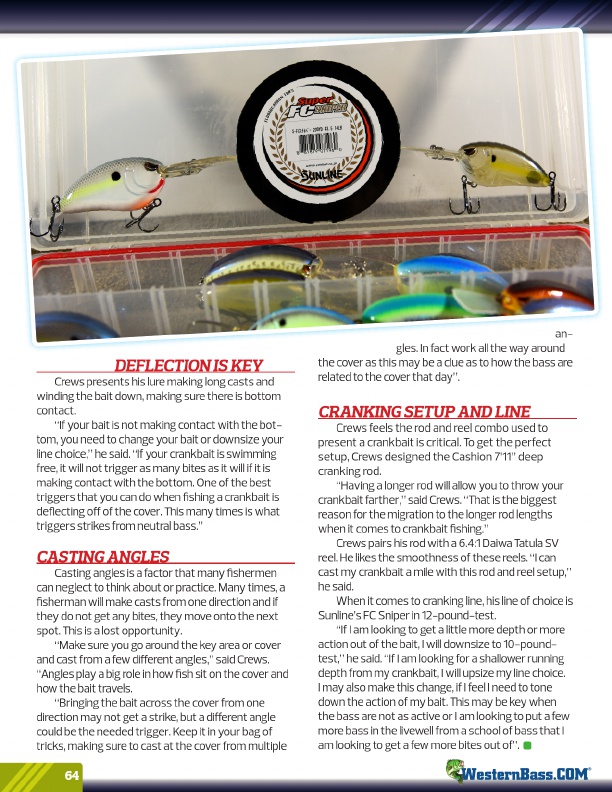
DEFLECTION IS KEY
Crews presents his lure making long casts and winding the bait down, making sure there is bottom contact.
“If your bait is not making contact with the bot- tom, you need to change your bait or downsize your line choice,” he said. “If your crankbait is swimming free, it will not trigger as many bites as it will if it is making contact with the bottom. One of the best triggers that you can do when fishing a crankbait is deflecting off of the cover. This many times is what triggers strikes from neutral bass.”
CASTING ANGLES
Casting angles is a factor that many fishermen can neglect to think about or practice. Many times, a fisherman will make casts from one direction and if they do not get any bites, they move onto the next spot. This is a lost opportunity.
“Make sure you go around the key area or cover and cast from a few different angles,” said Crews. “Angles play a big role in how fish sit on the cover and how the bait travels.
“Bringing the bait across the cover from one direction may not get a strike, but a different angle could be the needed trigger. Keep it in your bag of tricks, making sure to cast at the cover from multiple
64
an-
gles. In fact work all the way around the cover as this may be a clue as to how the bass are related to the cover that day”.
CRANKING SETUP AND LINE
Crews feels the rod and reel combo used to present a crankbait is critical. To get the perfect setup, Crews designed the Cashion 7’11” deep cranking rod.
“Having a longer rod will allow you to throw your crankbait farther,” said Crews. “That is the biggest reason for the migration to the longer rod lengths when it comes to crankbait fishing.”
Crews pairs his rod with a 6.4:1 Daiwa Tatula SV reel. He likes the smoothness of these reels. “I can cast my crankbait a mile with this rod and reel setup,” he said.
When it comes to cranking line, his line of choice is Sunline’s FC Sniper in 12-pound-test.
“If I am looking to get a little more depth or more action out of the bait, I will downsize to 10-pound- test,” he said. “If I am looking for a shallower running depth from my crankbait, I will upsize my line choice. I may also make this change, if I feel I need to tone down the action of my bait. This may be key when the bass are not as active or I am looking to put a few more bass in the livewell from a school of bass that I am looking to get a few more bites out of”.
®